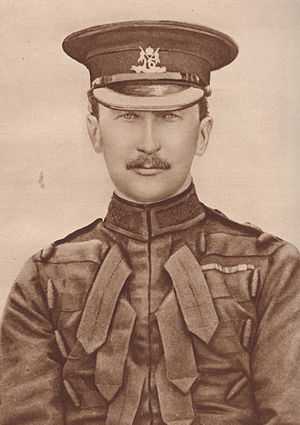Reserve Army (United Kingdom)
| Reserve Army | |
|---|---|
|
Lieutenant-General Hubert Gough | |
| Active |
First World War 1916 (renamed Fifth Army 30 October 1916) |
| Country | United Kingdom |
| Branch | British Army |
| Type | Army |
| Engagements |
Battle of Albert (1916) Battle of Flers–Courcelette Battle of Thiepval Battle of Le Transloy Battle of the Ancre Heights Battle of the Ancre (as the Fifth Army) |
| Commanders | |
| Notable commanders | Sir Hubert Gough |
| ||||||
The Reserve Army was a field army of the British Army and part of the British Expeditionary Force during the First World War. On 1 April 1916, Lieutenant-General Sir Hubert Gough was moved from the command of I Corps and took over the Reserve Corps, which in June before the Battle of the Somme, was expanded and renamed Reserve Army. The army fought on the northern flank of the Fourth Army during the battle and became the Fifth Army on 30 October.
History
The army was intended to carry out the breakthrough and exploitation of the Somme offensive, once the Fourth Army (General Sir Henry Rawlinson) had captured the German front-line trenches. In May it was envisaged that Gough would stand by to take over the two right flank corps of the Fourth Army but on 5 June this plan was supplemented by a proposal to move the forces under Gough to the Second Army, if the Fourth Army offensive bogged down. The idea of Gough taking over the right wing corps was dropped later in June and the 1st, 3rd and 2nd Indian cavalry divisions were attached to Gough along with the 12th and 25th divisions in GHQ reserve to operate under the command of the Fourth Army. II Corps with the 23rd and 38th divisions, was to be ready to move forward into the vacated assembly areas.[1]
In the evening of the First day on the Somme, 1 July 1916, the British Commander-in-Chief General Sir Douglas Haig relieved Rawlinson's Fourth Army of responsibility for the northern sector, placing the VIII and X Corps under Gough from 7:00 a.m. on 2 July. Gough immediately left to visit the two corps to assess the situation. X Corps and VIII Corps to the north were to capture the German front position and the intermediate line from Mouquet Farm to Serre. Gough was sent to take over command of X Corps and VIII Corps and the 25th Division (Major-General E. G. T. Bainbridge) was transferred from reserve to X Corps. Gough had intended to attack Thiepval with the 49th and 32nd divisions and the 48th Division of VIII Corps; eventually changes of plan reduced the attack to two brigades of the 32nd Division.[2]
Just before the attack by X Corps and III Corps began on 3 July, Gough revealed that X Corps could not attack before 6:00 a.m. and at noon, VIII Corps and X Corps were detached from the Fourth Army to Gough and the Reserve Army.[3] Later II Corps, I Anzac Corps and the Canadian Corps were added to the Reserve Army. For the next few months the Reserve Army fought the Battle of Pozières (23 July – 3 September) and the Battle of Mouquet Farm (16–26 September). The Battle of Thiepval Ridge (26–28 September took place as part of the sequential offensives of the French Sixth, the Fourth and then the Reserve Army during September. For much of October, the Reserve Army conducted the Battle of the Ancre Heights and on 30 October, the army was renamed the Fifth Army.[4][5]
Footnotes
- ↑ Edmonds 1932, pp. 258, 265, 267.
- ↑ Miles 1938, pp. 3–4, 11.
- ↑ Miles 1938, p. 11.
- ↑ Edmonds 1932, p. 193.
- ↑ Miles 1938, p. 460.
References
- Edmonds, J. E. (1932). Military Operations France and Belgium, 1916: Sir Douglas Haig's Command to the 1st July: Battle of the Somme. History of the Great War Based on Official Documents by Direction of the Historical Section of the Committee of Imperial Defence I (IWM & Battery Press 1993 ed.). London: Macmillan. ISBN 0-89839-185-7.
- Miles, W. (1938). Military Operations in France and Belgium: 2 July to the End of the Battles of the Somme. History of the Great War Based on Official Documents by Direction of the Historical Section of the Committee of Imperial Defence II (IWM & Battery Press 1992 ed.). London: Macmillan. ISBN 0-89839-169-5.
External links
| ||||||||||||||||||||||||||||||||||||||||||||||||||||||||||||||||||||||||||||||||||||||||||||||||||||||||||||||
